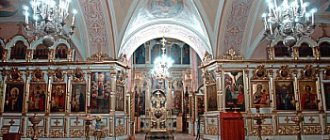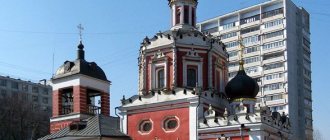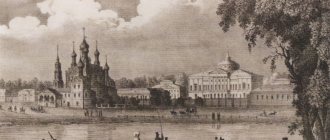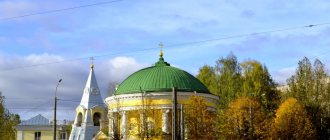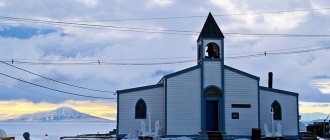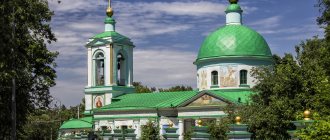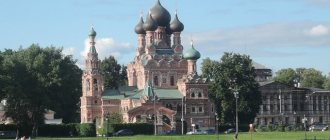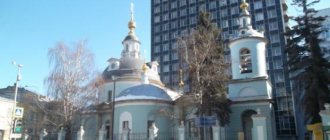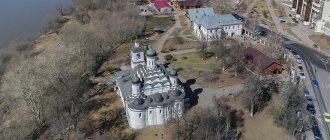| Moscow Patriarchal Metochion in honor of the 1000th anniversary of the Baptism of Rus' |
Moscow Church in honor of the Life-Giving Trinity in Orekhov-Borisov
, the patriarchal courtyard in honor of the 1000th anniversary of the Baptism of Russia within the Moscow diocese
- Throne: Life-Giving Trinity
- Address: Russia, Moscow, Kashirskoe highway, vl. 61a
- Website:
- On the map: Yandex.Map, Google map
The Trinity Church and other buildings of the patriarchal courtyard were erected on the banks of the Borisov Ponds, in a complex but picturesque landscape.
The buildings are visible from Kashirskoye Highway, from which a white-stone arched pedestrian bridge leads to the gate bell tower. The idea of building an administrative center of the Russian Orthodox Church was put forward in 1988, in connection with the celebration of the 1000th anniversary of the Baptism of Rus'. Official permission to build a new church in Moscow became a sensation at that time. The temple was founded on June 13, 1988 in the Tsaritsyn Ponds area, near the Kashirskoye Highway. The laying of the foundation stone of the temple was accompanied by a divine service with the participation of Patriarch of Moscow and All Rus' Pimen. At that time, the high priest expressed the meaning of the temple in the following words:
«So, the first stone has been laid in the foundation of the future temple, dedicated to the 1000th anniversary of the Baptism of Rus', a temple in memory of all our compatriots who laid down their lives in defense of the sacred borders of our Motherland in the Patriotic Wars
» [1].
A competition was held, in which the project of the architect Anatoly Polyansky won. The RSO was organized to build a temple in honor of the Millennium of the Baptism of Rus' (in 1990-1992 the director was Archpriest Sergius Suzdaltsev), but the start of work was postponed. In 1993, Polyansky died, and then the main temple-building project of the capital was the restoration of the Cathedral of Christ the Savior. As a result, construction of the temple began only thirteen years later, and the original project was radically revised. The area allocated for the new patriarchal courtyard in honor of the 1000th anniversary of the Baptism of Rus' was reduced by more than five times, and it amounted to 1,100 square meters.
In October 2000, the Baltic Construction Company began construction work. Church buildings began to be built in 2001. The first completed building was a chapel in the name of the blessed Prince Alexander Nevsky, and for two years, until the end of 2003, prayer services were held there on Sundays with the reading of akathists. After the chapel, the builders erected a gate bell tower. 11 bells (the largest weighing almost 2500 kilograms) cast from Voronezh were brought in 2001, in 2002 they were installed on the bell tower, and in 2003 a platform was built and a “control system” for the ringing was installed.
| Moscow Church of the Life-Giving Trinity in Orekhov-Borisov |
Meanwhile, work was progressing on the construction of the Church of the Life-Giving Trinity.
In 2001, a huge foundation pit was dug for the temple. To create it, numerous studies were carried out by highly qualified soil specialists. Immediately after the foundation was completed, the builders began building the frame of the future temple. The next stage in the construction was the construction of the roof of the exedra, then the construction of the main dome and the installation of the cross. The facade of the building was decorated with various bas-reliefs. Particularly labor-intensive work was carried out on the interior decoration of the temple, where expensive materials were used - marble, gilding. An elegant porcelain iconostasis made by the St. Petersburg art and restoration workshop “Guild of Masters” by Yuri Volkotrub was placed in the temple in the traditions of the Kuznetsov workshops of the century. The painting work was carried out under the guidance of the Honored Artist of Russia Vasily Nesterenko, and the group of icon painters was headed by Anna Belyanova. A baptistery for baptism through complete immersion was built in the basement of the temple. The buildings of the courtyard were decorated with mosaics made in the workshop of Ekaterina Ogorodnikova in St. Petersburg. The temple was rebuilt by the beginning of 2004. On May 19 of that year, Patriarch Alexy II consecrated the temple and served the first liturgy. Trinity Church became the second largest temple in the capital after the Cathedral of Christ the Savior. Since September 2004, a Sunday school has been opened in the courtyard for everyone, starting with children of four years of age. As of 2009, more than 250 pupils of different ages were studying at the farmstead; in addition to the Sunday school, there were various studios and clubs for children, a theater, and an icon painting school; took speech therapy classes and school preparation courses [2].
| Chapel of Alexander Nevsky of the Moscow Patriarchal Metochion in honor of the 1000th anniversary of the Baptism of Rus' |
History of the foundation of the temple
The construction of the Church of the Life-Giving Trinity in Borisov dates back to 1628. Then it was a wooden church, consecrated in honor of St. Nicholas the Wonderworker.
In the future, the following stages can be noted in the history of the temple:
- at the turn of the 17th - 18th centuries. a stone church was erected in the village, which was consecrated in honor of the Holy Trinity;
- by 1826 the church had become so dilapidated that it was forbidden to serve in it;
- the church was completely dismantled and rebuilt, consecration took place in 1829;
- in the period from 1870 to 1873, a new temple was built in a different place, two chapels appeared in it: in honor of St. Nicholas the Wonderworker and the Icon of the Mother of God “Quench My Sorrows.”
Church of the Holy Trinity in Borisov, Moscow
The old temple was not dismantled, although it was in a completely dilapidated state.
Interesting fact! The Moscow Archaeological Society, which considered it an architectural monument, prevented the dismantling of the old temple. There were no funds to restore the church, and in 1897 the community agreed that the old church needed to be dismantled.
During Soviet times, the temple was not operational by 1938. During the liquidation of the village, it was preserved, as it was recognized as a historical and architectural monument. In 1991, the Church of the Holy Trinity in Borisov was transferred to the Church and since that time services have been held there again.
History[edit]
The emergence of the village of Borisovo is associated with the name of Tsar Boris Godunov. At the end of the 16th century, Godunov built a developed cascade of ponds on the Gorodenka (Gorodne) River, which flowed through the palace estate. The Upper Pond began near the village of Chernaya Gryaz (later Tsaritsyno). On the shore of the last, eastern pond, the settlement of Borisovo arose - an economic village of the palace village of Kolomenskoye. The pond retained its ancient name “Borisovsky” or “Tsareborisovsky”. Borisovo was part of the palace lands (specific department) until 1917.
As a village with a church, according to the Kholmogorov researchers, Borisovo was first mentioned in the parish salary books of the patriarchal order for 1628. This means that before there was no church place here. The first wooden church was consecrated in honor of St. Nicholas. In the watch books of the Patriarchal government order of 1680, the Church of St. Nicholas the Wonderworker in the village of Borisov is also listed. Then a new, white stone church was built, consecrated in honor of the Holy Life-Giving Trinity. The exact date of its construction is not known. The Kholmogorovs discovered a document in 1710, where the temple appears as having already been built. It was a single-domed church with a hipped roof raised so high that it earned the name “tent roof.” The church had a semicircular altar, and the decoration of the facades was extremely sparse.
From 1710 to 1722 Priest Nikita Afanasyev and his son, sexton Dmitry, served in the church.
About the life of the village and the temple in the continuation of the 18th – early 19th centuries. no information has been preserved.
A document from 1826–1829 has been preserved. about the repair of a dilapidated temple. During the renovation process, the temple was dismantled to its foundations and rebuilt. A new iconostasis was installed and the icons were restored. On May 11, 1829, Trinity Church was re-consecrated.
The next document that has come down to us in time is a topographic map of the Moscow province of 1838, where the location of the Trinity Churchyard is clearly indicated. The church stands near the very shore of the pond, and there is a cemetery nearby.
In 1839, the village of Borisovo burned, and the church was also damaged, as follows from the document since then: “its walls are full of white stone, some brick.”
In the 1859s, a new priest, Father Nikolai Smirnov, was appointed to the Trinity Church in the village of Borisovo, “... From the first day of my arrival at my present place,” he wrote in one of his petitions to the diocesan authorities, “the situation of the temple of God aroused regret and fear in me . It was built of white stone and due to the lack of a vault, the dome was cracked in all directions. The iconostasis is painted in a sparse manner; it has lost its appearance due to dampness, the stone floor has crumbled, and the plank roof on the porch has become completely unusable. There is no fence or bell tower, but the bells hang on wooden poles. Such a pitiful state of the temple of God did not give me peace, so in 1862 I convinced the parishioners... to build a new warm stone church.”
Having received permission from Metropolitan Philaret, Father Nikolai in 1863 went to the Moscow Provincial Construction and Road Commission “to examine the correctness of the architecture” of “our chosen project,” which, after revision, was approved only a year later. No drawings have been preserved in the archives of the Construction and Road Commission. The name of the architect, the author of the project, was not included in the accompanying documentation.
Construction of the new church did not begin immediately: “There was only 1,400 rubles of church money,” continues Father Nikolai. , with such a sum it was impossible to make buildings. Therefore, permission was sought from His Eminence “to collect a donation for the book and print an invitation to donations in newspapers, and by May of last 1868, up to 4,000 rubles had been raised in our church.”
In the resolution of the Moscow Spiritual Consistory dated February 27, 1864, No. 1233, it was allowed “to leave the existing stone church, after dismantling its meal, for worship in it until the construction of a new stone church, and then allow it to be dismantled for the use of its material in the composition new bell tower." A lawsuit began, which ended with the fact that on June 19, 1869, “everyone agreed to build a new church near the existing one, opposite the priest’s house on an empty site and a convenient place for everyone.”
Construction proceeded slowly. Back in 1862, the peasants, by a general verdict, pledged to collect a silver ruble from each revision soul for the construction of the temple, but by 1870 “they had not collected a penny.” Carts for transporting building materials were also not supplied.
The church was built and consecrated in 1873, finishing continued until 1874. At the same time, a large bell was raised to the bell tower.
The old church, for some reason, was not immediately dismantled, although three altars were consecrated in the new church: Trinity - in the center, in the place where there is usually a passage from the refectory to the main church, and two side altars: the old St. Nicholas, and again built in the name of the icon of the Mother of God “Quench my sorrows.”
There was no service in the old church. But when the parishioners decided to break it down, the Imperial Commission for the Preservation of Ancient Monuments was already in action, and the clergyman of the Borisov church was forced to turn to the Moscow Archaeological Society to conduct an examination to determine whether the temple was a monument of ancient architecture and whether there were any obstacles to its dismantling.
The Moscow Archaeological Society prevented the demolition of the white stone temple for many years. In 1897, Diocesan Architect S. Krygin, “having examined this church, reported that... for more than 14 years... there have been no services, the roof is dilapidated, the frames are without glass, cracks are visible on all the walls in different directions... and the entire church visible dilapidation should be destroyed in the distant future...” The parishioners urgently asked the church to dismantle, to which the architect of the Moscow architectural society V. Gamburtsev finally gave permission, with the condition: “to disassemble with greater care and preserve the ancient parts found - voice boxes, stones with inscriptions And so on". November 17, 1897 The issue of dismantling the Borisov church was resolved in the affirmative.
The new temple had undergone changes by this time. In 1891, the bell tower was built on and strengthened with extensions. This was done because, as the priest explained in the petition, “because the houses of the parishioners are in a very low place between mountains and gardens,” and although the bell tower has a large bell weighing 300 pounds, “the low terrain and the five domes of the church stop the sound so much that the parishioners often they don’t hear his gospel at all...” Wanting to build a 10 arshin bell tower, the parishioners also planned to build extensions on both sides “in support of it.”
Work on the reconstruction of the temple ended in 1895. And on November 19, the consecration of the church took place, which was announced in the newspaper “Moskovskie Tserkovskie Tserkovye Vedomosti”. The project for the bell tower superstructure was not completed exactly. Instead of the planned intermediate half-tier, a full-fledged second tier was erected. This is evidenced by a photograph from 1938.
The white stone church was demolished in 1898, and in 1900 a chapel was erected on the site of the ancient altar. Drawings of this very simple structure, which is a small single-domed quadrangle with three windows and an entrance from the west, have been preserved. There is no signature of the architect under the project drawings.
In 1901, in the village, between two peasant houses, a chapel pillar was erected. His drawings have been preserved without a signature, but with the inscription: “Drawing from life of a chapel monument purchased for installation in the village of Borisov, Moscow province and district.” For what reason the chapel was erected is not clear.
In the same 1901, according to the design of the architect P. Blagoveshchensky, the church was equipped with calorific heating in the basement, and therefore hoods were made in the floor. The design drawings have been preserved. The oven was made under the northern extension to the bell tower; two arches were made from the extensions into the temple. It is curious that in the note accompanying the project the church is called a “refectory”.
In the same year, the same architect designed an altar, which the church so lacked, although it was very small. From the east, in the center, a pentagonal ledge was added to the volume of the temple, part of the eastern wall was taken out, and the opening from the temple to the room under the bell tower was slightly expanded. The church could not afford a large altar, otherwise it would go right up to the fence. Among the project drawings is a general plan with a fence delineating the border of the churchyard. In the north-eastern corner of the fence there was a chapel, nearby in the northern part there was a gate, and to the west, in the fence, there was a church house - a storeroom. The main gate was located in the eastern part of the fence, near the southeastern corner. Outside the fence, to the south, stood the priest's house. As in the general plan of the village, in this general plan the territory of the churchyard has an oblique configuration.
On August 18, 1902, the new altar was consecrated by Vicar Bishop Tryphon, which was immediately reported in the Moscow Church Gazette newspaper. Among the completed works were the replacement of the wooden floor with tiles, new paintings on the walls, and renovation of church utensils. “All these repairs cost at least 13,000 rubles.”
In 1906, the Trinity Old Believer community was formed in Borisov, officially registered in 1912. In 1915, an Old Believer prayer house was built in the village, or rather rebuilt from a hut. Design drawings signed by the architect Martyakov have been preserved. The Trinity Old Believer community invited the priests of the Rogozhskoe cemetery to perform the services.
In the summer, during the harvest season (hard summer work during the period of mowing, reaping and harvesting grain), religious processions were often held in the village of Borisov, for which they brought miraculous icons of the Mother of God of Jerusalem from the Izmailovo almshouse, St. Nicholas the Wonderworker from the Nikolo-Ugreshsky Monastery and the Great Martyr Catherine from the Catherine Hermitage.
The exact time the church closed is unknown. A photograph from 1938 has been preserved, some details of which indicate that the temple was already closed by that time. The domes and crosses were still in place, but the bells were no longer there. The metal bars in part of the fence were broken, and part of the northern spindle was dismantled. To the north of the temple, in the immediate vicinity of it, a hut was built. In the distance from the south you can see the old priest's house, and from the north, outside the fence, there was a non-residential wooden house, possibly a school. The photograph captures the moment when the pond was drained.
After its closure, the temple was converted into a grain warehouse for the Borisov state farm.
In 1978, the state farm was liquidated and the warehouse was removed from the church. The demolition of the village has begun, from which not a single house remains, but the routes of the main streets converging at the church are clearly visible. The cemetery was liquidated; not a single gravestone remained.
In 1960, the Tsaritsyno estate, and with it the entire cascade of Borisov ponds, was placed under state protection. Along with the Tsareborisovsky Pond, the Borisov Church was also put on guard, which was mistakenly named in the list of architectural monuments published by the State Control Department for the Protection of Historical and Cultural Monuments of Moscow as the “Church of the Virgin” (security No. 396).
The fence and chapel at the church were demolished, the priest's house was used for housing and disappeared along with the village. In Khrushchev’s times, on the site of the chapel, a village club with a pompous portico was built, which now houses a gym and an office.
This organization also owned a church building, in which in the 1980s. housed a motorcycle club garage. An office gatehouse was built on the church grounds and a fence was erected. The territory is littered, dug up by trenches of communications being laid. Since the late 1980s. the church building was not used. Since its closure, no repairs have ever been carried out, the roof is missing, and the vault of the northern extension to the bell tower has been dismantled. The constantly wet vaults are in disrepair. The floor was badly damaged. Paintings and iconostases were destroyed.”
In the early 1980s, the cascade of Borisov ponds was cleaned. The bank near the church is reinforced with a concrete structure. Trinity Church is part of the Tsaritsyno security estate, developed in 1978 by the NIPI General Plan of Moscow.
In 1991, the Trinity Church in Borisov was transferred to the Russian Orthodox Church.
Activities of the parish
The Church of the Holy Trinity in Borisov was handed over to the Orthodox community in a terrible state; in fact, only the walls remained. But in a short time it was possible to recreate the temple in its previous form and resume worship.
Divine service in the Church of the Life-Giving Trinity, Borisovo
Nowadays there is a Sunday school at the church, which carries out all the work on catechesis and religious education of the entire population of the region:
- The school day is Saturday;
- It is located in the Center for Continuing Education named after. St. Seraphim of Sarov, which is located at st. Yasenevaya, 33/2;
- Sunday school sponsors a social shelter for teenage children and correctional orphanage No. 9.
Also, the temple regularly organizes pilgrimage trips to the holy places of Russia.
How to get there[edit]
Address:
115563, Moscow, Borisovsky proezd, building 15, building 4
Directions:
- to the station metro station "Kashirskaya", then by bus number 275 towards the Moscow Ring Road to the stop "Borisovsky Proezd";
- to the station metro station "Domodedovskaya", then take bus number 275 to the side to the stop "Borisovsky Proezd";
- to the station metro station "Krasnogvardeyskaya", "Shipilovskaya" then take bus number 711 to the side.
Telephone:
+7 495 393 91 22 (temple), +7 916 264 47 76 (priest on duty)
Email:
Saints and shrines
A parishioner of the temple was Alexy Zverev, glorified by the Russian Orthodox Church as a new martyr. He was a member of the Local Council 1917 - 1918. and was a member of the commission to investigate the murder of Archbishop Andronik (Nikolsky) of Perm.
Among the most revered shrines of the temple:
- icon of the blessed Matrona of Moscow (on her is a saint with open eyes);
- icon of the holy martyr. Alexia Zvereva;
- icon of the Dormition of the Mother of God with a piece of the Holy Sepulcher;
- ancient icons of the archangels Michael and Gabriel;
- icons of the Mother of God “Quick to Hear”, “Seeking the Lost”, “Sovereign”, “Quiet My Sorrows”;
- icon of St. Nicholas the Wonderworker.
Iconostasis of the Church of the Life-Giving Trinity in Borisov
Pilgrim[edit]
Schedule of services:
- Daily – Divine Liturgy at 8-00;
- Daily – Vespers and Matins at 17-00;
- On Sundays – Divine Liturgy 7-00 and 10-00;
- On the days of the twelve and great holidays - Divine Liturgy - at 7-00 and 10-00 o'clock; the day before the All-Night Vigil (vespers and matins) at 17-00 hours.
- On Sundays at 5:00 p.m. Vespers is read with an akathist to the Mother of God “Quench my sorrows,” “St. Nicholas" (one by one).
Public conversations before receiving the Sacrament of Baptism in our church are held on Wednesdays and Sundays from 15.00 to 17.00
For the current schedule of services, see the official website of the temple
